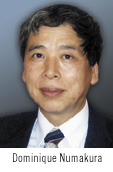
As prices drop each year, what's a consumer OEM to do?
Samsung Electronics, the Korean consumer electronics giant, posted quarterly revenue of 13.96 trillion won (about U.S. $15 billion), representing 1% growth compared to the first quarter of 2005. But income declined 25% to 1.61 trillion won. The company blamed the shortfall on the recent appreciation of the Korean won against the U.S. dollar, coupled with significant market price declines for semiconductor devices (-19%) and cellular phones (-45%).
Other sources indicated that Samsung itself could be the reason for declining prices. Samsung Electronics offered a very aggressive price for flash memory as the alternative memory device for the micro drives in Apple's iPod.
Large LCD panels are still a significant source for sustaining an increase in income. First quarter profit increased 360% to 110 billion won compared to the first quarter of 2005. The profit increase was realized even though large manufacturers in Japan, Korea and Taiwan are embroiled in a price war. Market prices for end-products such as flat panel TVs decline more than 30% every year. Large manufacturers plan to reduce costs by expanding business and increasing manufacturing capacities. They speculate that LCD devices have an incredible growth potential.
There is one other way to reduce manufacturing costs. Lower costs for raw materials, components and printed circuit boards would translate into lower prices; however, it is almost impossible for suppliers to reduce costs by 30%.
It is a risky game. Lowering manufacturing cost is a great strategy for expanding markets and beating competition, but the reality is that manufacturers offer low prices first, and then try to reduce manufacturing costs to make profit.
Generally, falling prices occur rapidly in the consumer electronics market, and it is not easy to lower costs just as fast. In a growing market, there are some possibilities to make profits, but unfortunately, this market is not infinite. One day the manufacturers will see this game end. And some suppliers have already dropped out of the race.
Headlines
CMK, a major PCB company in Japan, will invest 12 billion yen to found a new PCB manufacturing plant in Thailand.
Fuji Films is constructing a new plant of TAC films for LCD devices. The company has decided to also build second and third plants to cover the booming demands.
Samsung SDI, a major display supplier in Korea, will invest 730 billion won to build its fourth manufacturing line for PDP devices. The new line starts the production in May 2007 with a capacity of 3 million 42õ panels per year.
Funai Electric, a major consumer electronics vendor in Japan, will invest 10 billion yen to increase by eightfold its LCD TV production capacity in overseas operations, to 5 million units per year by 2007.
NICT, an R&D organization in Japan, has developed a new flexible IC TAG formed on a cloth substrate. It can be attached on non-flat surfaces such as human bodies.
Oki Electric, a major electronics company in Japan, has developed a new 13-bit source driver chip for LCD devices. The new devices are mounted on TCP substrates.
TDK will terminate its CD-DVD business because of the small margin. The market prices are declining too quickly.
Polar Instruments has opened a new design/marketing office in Yokohama, Japan, to penetrate the Japanese electronics market.
Shirai Denshi, a major PCB manufacturer in Japan, plans to found new plants in Asia - not China - to reduce business risks. The company already has four facilities in China.
Dai-Nippon Screen, a major equipment manufacturer in Japan, has rolled out a new AOI machine for ultra high-density circuit boards. The new machine has a high-speed capability of .0005õ lines/spaces.
Matsushita Electric Industry will invest 20 billion yen in its Amagasaki plant to increase the manufacturing capacity for PDP devices 30%, to 460,000 panels per month.
Seiko Epson has developed a new inkjet printing process of silicon base semiconductors to reduce the cost of large LCD panels.
SMK, a major component supplier in Japan, has rolled out a new low-height (3 mm) camera module as the sub-camera system for 3G cellular phones.
Hitachi Chemical, a major material supplier for PCBs in Japan, will invest 3 billion yen to start a dry film manufacturing operation for in Suzhou, China in February 2007. PCD&M
Dominique Numakura is president of DKN Research; This email address is being protected from spambots. You need JavaScript enabled to view it..












